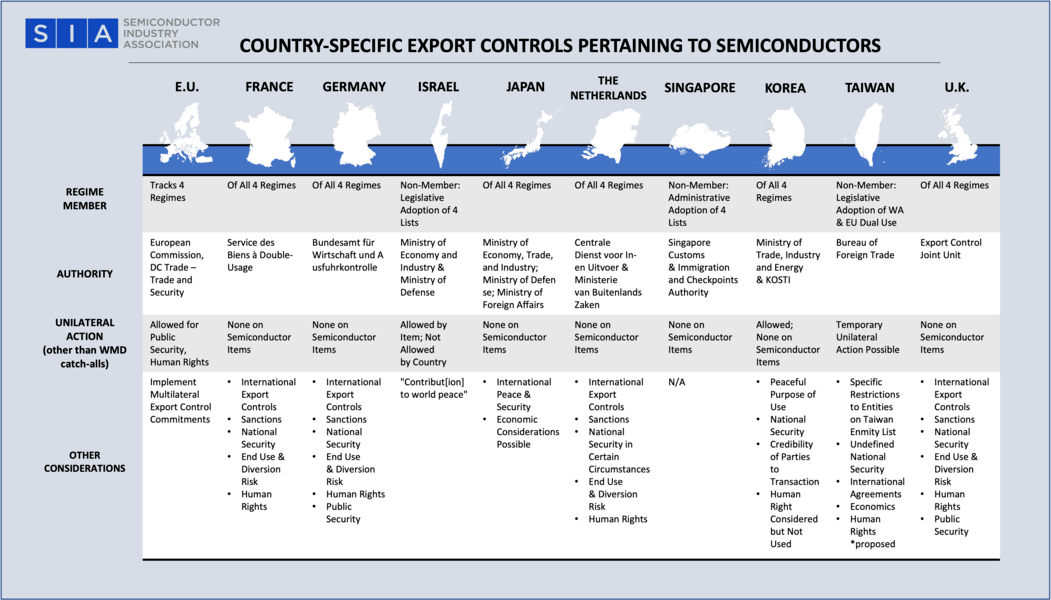SIA Encourages the United States and Europe to Collaborate on Export Control Policy
Thursday, Jan 20, 2022, 12:00pm
by Semiconductor Industry Association
Overseas market access and a level global playing field are critical for U.S. leadership and competitiveness in semiconductors. The U.S. semiconductor industry relies on overseas markets for more than 80% of its sales, which U.S. firms re-invest into research and development efforts to out-innovate foreign competitors. A report by the Boston Consulting Group (BCG) termed this phenomenon a “virtuous cycle,” which is essential to maintaining U.S. leadership in semiconductor technology.[1] Access to overseas markets must be complemented by a level-playing field with respect to export controls to achieve industry success, and national security and foreign policy objectives. Harmonizing the scope, application, and enforcement of export controls among foreign partners helps to remove unnecessary burdens, enhance compliance, and achieve a fair and competitive market for U.S. industry.
SIA supports the U.S. and EU Trade and Technology Council (TTC) efforts to coordinate approaches to export controls under the Export Control Working Group (ECWG), and has submitted a response to the Department of Commerce’s (Commerce) Request for Information on Areas and Priorities for U.S. and EU Export Control Cooperation under the TTC Export Control Working Group (ECWG). The SIA submission provides specific proposals, recommendations and analysis on how to adopt tailored, consensus-based export controls based on legitimate and sound national security goals.
[DOWNLOAD SIA’S COMMENTS]
SIA and its members share Commerce’s goal of leveraging the ECWG to “enhance international security and the protection of human rights, and support a global level-playing field and joint technology development and innovation”, and recommend these efforts focus on five key domains:
- Harmonization and alignment of license exceptions and general authorizations;
- Alignment and clarification of authorities and common strategic-level policy objectives;
- Harmonization of regulatory structures, definitions, and policies;
- Harmonization and alignment across human rights controls and policies;
- Additional items that support the overall convergence of U.S.-EU export controls.
Fully multilateral solutions to export control are the ideal solution to ensure that policy objectives are met effectively while preserving a level-playing field. However, it is often difficult to achieve consensus in large multilateral regimes, which has spurred discussions on a new approach to find consensus among smaller groupings of countries. To succeed, consensus-based approaches must navigate unavoidable differences between countries’ commercial, economic, national security and foreign policy concerns, as well as their export control laws and policies.
Recognizing these challenges, SIA submitted as a response to this RFI, a ground-breaking assessment of international export control authorities across ten key countries and regions with significant semiconductor industries. This assessment is intended to serve as a resource for stakeholders navigating the challenging but important approach of consensus-building on multilateral export controls. The following chart provides an overview of the similarities and differences between the U.S. and partner country export control systems as presented in this analysis (more details can be found on each country in the linked assessment):

SIA looks forward to working with the Administration and with the TTC ECWG to make real progress towards TTC objectives of deepened relations and coordination – which SIA welcomes and shares. Building convergence across multiple borders, governments, and legal systems on these highly complex issues is a challenging effort but critical for our collective national interests. SIA applauds the efforts of the U.S. and EU governments and stands ready to support.
[1] https://www.bcg.com/en-us/publications/2020/restricting-trade-with-china-could-end-united-states-semiconductor-leadership
